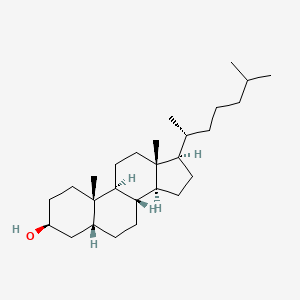| Desmarchelier C et al. |
C57Bl/6 N mice on a western diet display reduced intestinal and hepatic cholesterol levels despite a plasma hypercholesterolemia. |
2012 |
BMC Genomics |
pmid:22394543
|
| Furtula V et al. |
Inorganic nitrogen, sterols and bacterial source tracking as tools to characterize water quality and possible contamination sources in surface water. |
2012 |
Water Res. |
pmid:22197263
|
| Hope BK et al. |
A state-wide survey in Oregon (USA) of trace metals and organic chemicals in municipal effluent. |
2012 |
Sci. Total Environ. |
pmid:22244355
|
| Daughton CG |
Real-time estimation of small-area populations with human biomarkers in sewage. |
2012 |
Sci. Total Environ. |
pmid:22137478
|
| Souza DS et al. |
Evaluation of tropical water sources and mollusks in southern Brazil using microbiological, biochemical, and chemical parameters. |
2012 |
Ecotoxicol. Environ. Saf. |
pmid:22036209
|
| Nochioka K et al. |
Ezetimibe improves endothelial function and inhibits Rho-kinase activity associated with inhibition of cholesterol absorption in humans. |
2012 |
Circ. J. |
pmid:22640986
|
| Rogacev KS et al. |
Cholesterol synthesis, cholesterol absorption, and mortality in hemodialysis patients. |
2012 |
Clin J Am Soc Nephrol |
pmid:22461539
|
| Lahti M and Oikari A |
Vertical distribution of pharmaceuticals in lake sediments-citalopram as potential chemomarker. |
2012 |
Environ. Toxicol. Chem. |
pmid:22639393
|
| Pande S et al. |
Antihypercholesterolaemic influence of dietary tender cluster beans (Cyamopsis tetragonoloba) in cholesterol fed rats. |
2012 |
Indian J. Med. Res. |
pmid:22561629
|
| Martins CC et al. |
Multi-molecular markers and metals as tracers of organic matter inputs and contamination status from an Environmental Protection Area in the SW Atlantic (Laranjeiras Bay, Brazil). |
2012 |
Sci. Total Environ. |
pmid:22244354
|
| Ostrowska M et al. |
Cerebrotendinous xanthomatosis: a rare cause of spinocerebellar syndrome. |
2011 Nov-Dec |
Neurol. Neurochir. Pol. |
pmid:22212991
|
| Lupattelli G et al. |
Patterns of cholesterol metabolism: pathophysiological and therapeutic implications for dyslipidemias and the metabolic syndrome. |
2011 |
Nutr Metab Cardiovasc Dis |
pmid:21855307
|
| Yamamoto M et al. |
Structural requirements of virion-associated cholesterol for infectivity, buoyant density and apolipoprotein association of hepatitis C virus. |
2011 |
J. Gen. Virol. |
pmid:21593275
|
| RodrÃguez-Cantú LN et al. |
Broccoli ( Brassica oleracea var. italica) sprouts and extracts rich in glucosinolates and isothiocyanates affect cholesterol metabolism and genes involved in lipid homeostasis in hamsters. |
2011 |
J. Agric. Food Chem. |
pmid:21254774
|
| Benesch MG et al. |
Sterol chemical configuration influences the thermotropic phase behaviour of dipalmitoylphosphatidylcholine bilayers containing 5α-cholestan-3β- and 3α-ol. |
2011 |
Chem. Phys. Lipids |
pmid:21055394
|
| Inoue T et al. |
Inhibition of intestinal cholesterol absorption might explain cholesterol-lowering effect of telmisartan. |
2011 |
J Clin Pharm Ther |
pmid:21198725
|
| Vilela CG et al. |
Benthic foraminifera distribution in a tourist lagoon in Rio de Janeiro, Brazil: a response to anthropogenic impacts. |
2011 |
Mar. Pollut. Bull. |
pmid:21871637
|
| Solecki O et al. |
Persistence of microbial and chemical pig manure markers as compared to faecal indicator bacteria survival in freshwater and seawater microcosms. |
2011 |
Water Res. |
pmid:21745675
|
| Andrási N et al. |
Derivatization and fragmentation pattern analysis of natural and synthetic steroids, as their trimethylsilyl (oxime) ether derivatives by gas chromatography mass spectrometry: analysis of dissolved steroids in wastewater samples. |
2011 |
J Chromatogr A |
pmid:21367426
|
| Niesor EJ et al. |
Effect of dalcetrapib, a CETP modulator, on non-cholesterol sterol markers of cholesterol homeostasis in healthy subjects. |
2011 |
Atherosclerosis |
pmid:21982411
|
